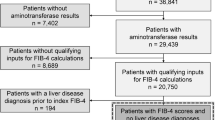Abstract
Objectives
Although effective HCV treatment is available, it can be difficult to access for uninsured, urban patients. Our aim was to assess the utility of evaluation and outcomes in the uninsured with HCV when access to health care and treatment with triple therapy is provided.
Methods
We performed a retrospective review of consecutive patients referred for HCV from 2011 to June 2013 to an indigent HCV clinic. The primary outcomes were assessment of disease severity by noninvasive means and initiation of therapy.
Results
We identified 350 patients: mean age 50.6, 84 % with no insurance, 62 % men, 58 % black, 91 % HCV treatment naïve. Of these, 148 underwent liver biopsy and 68 % had F0–F1 and 10 % had F3–F4 fibrosis. FIB-4 and APRI were highly correlated (r = 0.9; p < .0001) and correctly classified patients by fibrosis strata (F0–F1, F2, and F3–F4; p = .0004). When combined, a FIB-4 ≤1.5 and APRI ≤0.5 correctly classified the absence of advanced disease in 97 % (p < .0001). Of those evaluated, 39 (11 %) went on to HCV treatment. Of those not in a clinical trial, 51 % completed treatment with SVR in 61 % with genotype 1 and 75 % in genotypenon-1. Of those not treated (n = 309), the most common reasons were mild disease (16 %), lost to follow-up (23 %), ongoing alcohol or substance abuse (24 %), and uncontrolled depression (10 %).
Conclusion
Noninvasive assessment can accurately exclude advanced fibrosis. Despite access to care, the utility of evaluating to initiate HCV treatment is low suggesting that eliminating the barrier to health care may not increase HCV treatment.


Similar content being viewed by others
References
Salomon JA, Weinstein MC, Hammitt JK, Goldie SJ. Empirically calibrated model of hepatitis C virus infection in the United States. Am J Epidemiol. 2002;156:761–773.
Armstrong GL, Wasley A, Simard EP, et al. The prevalence of hepatitis C virus infection in the United States, 1999 through 2002. Ann Intern Med. 2006;144:705–714.
Louie KS, Laurent S, Forssen UM, et al. The high comorbidity burden of the hepatitis C virus infected population in the United States. BMC Infect Dis. 2012;12:86.
Ong JP, Collantes R, Pitts A, et al. High rates of uninsured among HCV-positive individuals. J Clin Gastroenterol. 2005;39:826–830.
Putka B, Mullen K, Birdi S, et al. The disposition of hepatitis C antibody-positive patients in an urban hospital. J Viral Hepat. 2009;16:814–821.
Chander G, Sulkowski MS, Jenckes MW, et al. Treatment of chronic hepatitis C: a systematic review. Hepatology. 2002;36:S135–S144.
Chung RT. A watershed moment in the treatment of hepatitis C. N Engl J Med. 2012;366:273–275.
Poordad F, McCone J Jr, Bacon BR, et al. Boceprevir for untreated chronic HCV genotype 1 infection. N Engl J Med. 2011;31(364):1195–1206.
Jacobson IM, McHutchison JG, Dusheiko G, et al. Telaprevir for previously untreated chronic hepatitis C virus infection. N Engl J Med. 2011;364:2405–2416.
Bacon BR, Gordon SC, Lawitz E, et al. Telaprevir for previously untreated chronic hepatitis C virus infection. N Engl J Med. 2011;23(364):1207–1217.
Stepanova M, Kanwal F, El-Serag HB, et al. Insurance status and treatment candidacy of hepatitis C patients: analysis of population-based data from the United States. Hepatology. 2011;53:737–745.
Moirand R, Bilodeau M, Brissette S, et al. Determinants of antiviral treatment initiation in a hepatitis C-infected population benefiting from universal health care coverage. Can J Gastroenterol. 2007;21:355–361.
McGowan CE, Monis A, Bacon BR, et al. A global view of hepatitis C: physician knowledge, opinions, and perceived barriers to care. Hepatology. 2013;57:1325–1332.
Fusfeld L, Aggarwal J, Dougher C, et al. Assessment of motivating factors associated with the initiation and completion of treatment for chronic hepatitis C virus (HCV) infection. BMC Infect Dis. 2013;13:234.
Wai CT, Greenson JK, Fontana RJ, et al. A simple noninvasive index can predict both significant fibrosis and cirrhosis in patients with chronic hepatitis C. Hepatology. 2003;38:518–526.
Sterling RK, Lissen E, Clumeck N, et al. Development of a simple noninvasive index to predict significant fibrosis in patients with HIV/HCV coinfection. Hepatology. 2006;43:1317–1325.
Smith BD, Morgan RL, Beckett GA. Hepatitis C virus testing of persons born during 1945–1965: recommendations from the Centers for Disease Control and Prevention. Ann Intern Med. 2012;157:817–822.
Lynn RB. Hepatitis C virus testing of persons born during 1945–1965. Ann Intern Med. 2013;158:704–705.
Bruno S, Stroffolini T, Colombo M, et al. Sustained virological response to interferon-alpha is associated with improved outcome in HCV-related cirrhosis: a retrospective study. Hepatology. 2007;45:579–587.
Alberti A. Impact of a sustained virological response on the long-term outcome of hepatitis C. Liver Int.. 2011;31:18–22.
Veldt BJ, Heathcote EJ, Wedemeyer H, et al. Sustained virologic response and clinical outcomes in patients with chronic hepatitis C and advanced fibrosis. Ann Intern Med. 2007;147:677–684.
Backus LI, Boothroyd DB, Phillips BR, et al. A sustained virologic response reduces risk of all-cause mortality in patients with hepatitis C. Clin Gastroenterol Hepatol. 2011;9:509–516.
Chen EY, Sclair SN, Czul F, et al. A small percentage of patients with hepatitis C receive triple therapy with boceprevir or telaprevir. Clin Gastroenterol Hepatol. 2013;11:1014–1020.
Holmberg SD, Spradling PR, Moorman AC, Denniston MM. Hepatitis C in the United States. N Engl J Med. 2013;368:1859.
Kanwal F, White DL, Tavakoli-Tabasi S. Many patients with interleukin 28B genotypes associated with response to therapy are ineligible for treatment because of comorbidities. Clin Gastroenterol Hepatol.. 2014;12:327–333.
Surjadi M, Torruellas C, Ayala C, et al. Formal patient education improves patient knowledge of hepatitis C in vulnerable populations. Dig Dis Sci. 2011;56:213–219.
Smith JO, Sterling RK. Systematic review: noninvasive methods of fibrosis analysis in chronic hepatitis C. Aliment Pharmacol Ther. 2009;30:557–576.
Bonder A, Afdhal N, et al. Utilization of FibroScan in clinical practice. Curr Gastroenterol Rep. 2014;16:372.
Conflict of interest
None.
Author information
Authors and Affiliations
Corresponding author
Rights and permissions
About this article
Cite this article
Donepudi, I., Paredes, A., Hubbard, S. et al. Utility of Evaluating HCV in an Uninsured Population. Dig Dis Sci 60, 1092–1097 (2015). https://doi.org/10.1007/s10620-014-3416-8
Received:
Accepted:
Published:
Issue Date:
DOI: https://doi.org/10.1007/s10620-014-3416-8




